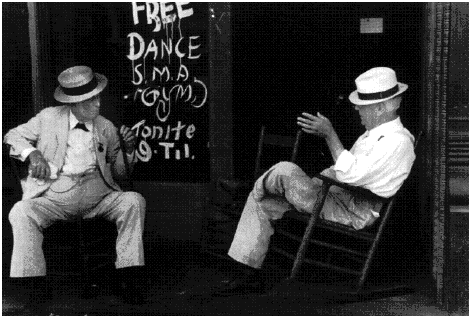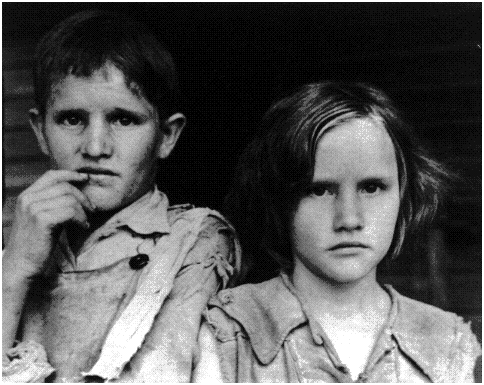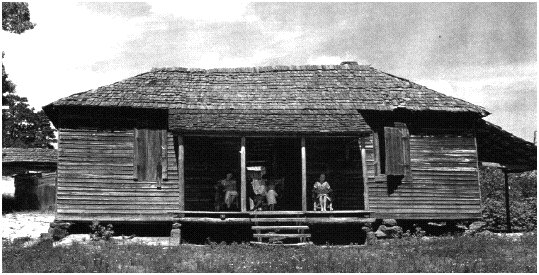

In his introduction to Let Us Now Praise Famous Men, Agee tells us that what he has done is not art, certainly not Art, don't call it art. He tells us it is something else again --- perhaps a disease, perhaps a fury, and if we are to understand it, we are to put Beethoven's Seventh or Schubert's C-Major Symphony on the phonograph and "turn it up loud" and then "get down on the floor" and "jam your ear as close into the loudspeaker as you can get it and stay there, breathing as lightly as possible, and not moving, and neither eating nor smoking nor drinking."
You won't hear it nicely. If it hurts you, be glad of it. As near as you will ever get, you are inside the music; not only inside it, you are it; your body is no longer your shape and substance, it is the shape and substance of the music.
This, he wants us to know, is how we are to understand his work.
Let us now praise famous men and our fathers that begat us. The quotation is from Sirach --- also known as Ecclesiasticus --- one of the Apocrypha of the Old Testament. The irony of the words is obvious and biting, for Agee is describing, minutely, the least famous, the poorest of the poor, the men (and women, and children) who lived in and around central Alabama in the middle of the depression, in the summer of 1936.
If you have never read Agee you might consider the possibility of dropping this review and calling up the American Book Exchange or Powells to get a copy of Let Us Now Praise Famous Men so that you don't have to waste your time in having me tell you what a fine piece of work it is. Barring that, let me say that it's the work of a young man (twenty-seven) who knows words and knows how to use them and wants us to see and hear and smell and feel what it is like to be intimately involved with three families who are certainly not famous but certainly are poor --- "dirt poor" as we used to say.
Agee has set out to bring us into this world, and he does it with a vengeance. It is apparent that he is trying to do with words what companion Walker Evans did with the sixty-four pages of photographs that appear in this volume.
In addition to what some might call the excesses of description --- the exact shape and feel and color and texture of a pair of overalls take the better part of a page --- we have precise word-pictures of three families, their children, their houses, the rooms, the furniture, the walls, the chicken coops, the land, the land under the houses, the roofs of the houses, the feel of the sun, the heat in the kitchen, the dying trees, the dust, the withering crops.
In the hands of a lesser writer, these could be dumb beyond belief; in the hands of this poet --- for he is a poet, and a musician --- they often take surprising turns that pull one in. To those of us who have lived in or at least visited this part of the world, the prose brings back a flood of sensual memories. Here is the single dresser in the Gudger's shack:
The bureau was at some time a definitely middle-class piece of furniture. It is quite wide and very heavy, veneered in gloomy red rich-grained woods, with intricately pierced metal plaques at the handles of the three drawers, and the mirror is at least three feet tall and is framed in machine-carved wood.
So far, so good --- we know that bureau, and we have seen the likes of it. Now Agee will personalize it:
The veneer has now split and leafed loose in many places from the yellow soft-wood base; the handles of the three drawers are nearly all deranged and two are gone; the drawers do not pull in and out at all easily.
Not only has he given our bureau age and substance --- he has plopped in a word that almost sounds out-of-place (drawers that are "deranged") but which, as we continue, turns perfect, the necessary connotations of crazy, undisciplined, askew:
The mirror is so far corrupted that it is rashed with gray, iridescent in parts, and in all its reflections a deeply sad thin zinc-
to- platinum, giving to its framings an almost incalculably ancient, sweet, frail, and piteous beauty, such as may be seen in tintypes of family groups among studio furnishings or heard in nearly exhausted jazz records made by very young, insane, devout men who were to destroy themselves, in New Orleans, in the early nineteen twenties. In a hundred words or so, Agee has given us an exact portrait of an old bureau mirror, bringing in melancholy, sweetness, insanity ("deranged"), adding words that might not (for others) belong ("rashed" "sad"), juxtapositions which are in themselves rash ("insane, devout") --- a word play montage that takes us from this one room into tintype photographs and out to the world of jazz musicians who are devout, insane (again), tired ("exhausted" --- a record that has been played too many times) and, finally, self-destructive.
Or take this, on the exact smell of the Gudgers' house:
The odor of pine lumber, wide thin cards of it, heated in the sun, in no way doubled or insulated, in closed and darkened air. The odor of woodsmoke, the fuel being again mainly pine, but in part also, hickory, oak, and cedar. The odors of cooking. Among these, most strongly, the odors of fried salt pork and of fried and boiled pork lard, and second, the odor of cooked corn. The odors of sweat in many stages of age and freshness, this sweat being a distillation of pork, lard, corn, woodsmoke, pine, and ammonia. The odors of sleep, of bedding and of breathing, for the ventilation is poor. The odors of all the dirt that in the course of time can accumulate in a quilt and mattress. Odors of staleness from clothes hung or stored away, not washed.
With these two (snapshot of dresser; snippet of aromas), we are there, in Hobe's Hill, Alabama, in the hot summer of 1936. It is a writing that is cumulative, exactly defining a piece of furniture, or defining one odor, then another, then reweaving them together, then accumulating yet another. It becomes, in his hands, poetry and music, for music appears regularly as a counterpoint to the words, telling us to "lie on the floor" and subject ourselves to the pain and the beauty of it.

It's serious stuff, but, too, Agee sprinkles a few jokes around here and there --- such as taking time off (he calls it an "Intermission") to excoriate the editors of Partisan Review for a questionnaire on "art." Or in the beginning "Persons and Places," he lists all members of the three families, then,
James Agee: a spy, traveling as a journalist.
Walker Evans: a counter-spy traveling as a photographer.And as "unpaid agitators,"
William Blake
Louis-Ferdinand Céline
Ring Lardner
Jesus Christ (referred to earlier as "a dirty gentile")
Sigmund Freud
Lonnie Johnson
Irvine Upham.Agee says at one point that he would prefer it if people would read the book aloud. With its heavy Biblical overtones, with its beautiful circular writing, with its poetry, and music --- it becomes a classic of American literature, as important (in its eccentric way), as Winesburg, Ohio, Huckleberry Finn, The Catcher in the Rye, The Great Gatsby, The Sound and the Fury, A Farewell to Arms. It is high time that it is rediscovered, and the publishers deserve thanks for bringing it back in this fine edition.
